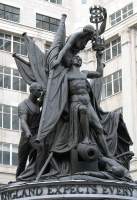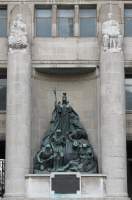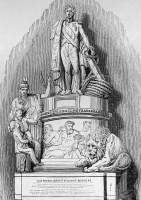 Nelson Monument, Liverpool.
Nelson Monument, Liverpool.
Liverpool’s monument to Nelson stands in the open area behind the Town Hall, known as Exchange Flags. It is a quite remarkable work, and it is odd that more is not made of it. What we have is a pyramidal baroque composition of figures of the sort found in Westminster Abbey, in Guildhall, and in the occasional cathedral, but not out of doors, where the rule for these largest monuments is to have some architectural construction with places for the individual figures (think of the Victoria or Albert Memorials in London, or the Victoria memorial in Liverpool for that matter), or a frieze or pediment which constrains them (for example on the front of the British Museum). So I think the upper part of Liverpool’s Nelson monument is very unusual, if not unique among outdoor English memorials, with its heap of cannon and flags, the figure of Nelson among them, a sailor, angel and skeleton, a recumbent figure, and behind, a weeping Victory – six figures in all. Beneath, on short plinth, are four seated slaves, bringing our figure count to 10, with four panels between them. Below that, a tall step, with cast iron grills bearing six- and twelve-pointed stars.
The sculptor was Sir Richard Westmacott RA – we have to be careful with the name, because there were three eponymous sculptors in this sculptural dynasty. The design however, was by Matthew Cotes Wyatt (1777-1862), one time designer and painter, later sculptor. The work dates from the 1800s, with the unveiling in 1813: it was the first major sculpture in Liverpool.
Of the whole composition, it is the figure of Nelson himself which is perhaps most uneasy to modern eyes. He is shown at the point of rising up to Heaven, and his eyes cast upwards in the way common in religious paintings of the time looks mannered rather than pious. He is shown without clothes, which is one way of overcoming the difficulty of having contemporary clothes on the one hand (still unusual for heroic monuments in the 1800s), and classical robes on the other (unrecognisable as Nelson). The heroic nude male figure has a good pedigree – for example Roman emperors were sometimes shown thus. Or we can consider it as like a tomb monument, when the naked figure would signify the soul as opposed to the corporeal man. Regardless, his figure, rather anatomical, is heavily muscular, and the problem of his missing arm is overcome by having it draped under one of the flags. He holds a sword, or something approaching a sword, plunging upwards through a series of crowns – a strange conception which might not be quite as originally, perhaps to avoid theft. One foot is on a cannon, the other, on the body of some fallen figure, lying with his arm sprawled forward. To the left of the composition, behind one of the flags, is the sailor, stepping forward, another muscular figure; there to provide balance to this side of the composition.
Above, the angel is an exquisite figure, leaning forward and above Nelson, her light drapes accentuating rather than concealing her figure, and the folds of the drapery over her left leg are particularly well captured. Her left arm is raised and so far back that this would be a rather strained position to hold, but perhaps for a supple young maiden it would not be so.
The rise of Nelson is being constrained by the figure of Death, as a skeleton, emerging from under cowl of sailcloth and clawing at Nelson’s chest – this really is something out of a Westminster Abbey monument. While it adds to Baroque effect, we could imagine a purer classical composition without it.
We must linger on the figure at the back, the Britannia, with Union Jack shield and anchor pushing out underneath, holding a wreath, with Corinthian helm, but head bowed in sadness at the death of the hero. This is a very excellent figure, and it is worth visiting the monument just to see this one statue. Several more Britannia's are shown on this page.
The four slaves shackled below are further studies of the male nude, seated in contorted positions of hopelessness and despair. All are of heroic proportions, and particularly admirable is the one resting on his elbow, who recalls somewhat the gladiators of ancient Rome.
Finally the four panels, which show episodes from Nelson’s career. Each shows ten or a dozen figures in high and low relief, with something approaching contemporary clothing and hairstyles, but plenty of exposed chests and arms and flying draperies of one sort and another to allow for a heroic Classical treatment. Their subjects have been well described elsewhere.
So this is the Nelson monument in Liverpool. We may note that also on Exchange Flags is an interesting World War I memorial, again pyramidal in composition, with a summit Britannia above a group of soldiers, advancing, with a piece of heavy artillery, and one of the group, wounded, being tended by a nurse. The bronze group rests set back between two stone pillars, with apparently more modern emblematic stone figures above – a woman holding an infant, and a man with his arms round a growing boy. Joseph Philips was the sculptor of the central group, and I have not seen other works by him.
 World War 1 memorial, by Joseph Philips.
World War 1 memorial, by Joseph Philips.
Facing the Nelson monument is the rear elevation of the Old Town Hall, with four stone status above a porch raised on pairs of Corinthian pillars. These are very worn, due to their exposed position, and include a woman with a cornucopia, some other young heroic female with a cloak, a third with long hair and a cornucopia resting on the ground, and a fourth figure holding perhaps a rudder. The loss of material due to weathering has left them looking rather disproportionate, but the last figure retains enough elegance to indicate the sculptor was of some considerable skill.
Above, on the summit of the dome, we see the rear view of another Britannia, by J.C.F. Rossi. (As noted, for various other figures of Britannia, see this page.)
Around the building, high up above the windows, are a variety of small panels with sculptured heads, anchors and other emblems of Liverpool’s maritime associations, and of the places Liverpool’s port does trade with, and the odd hippogryphs and other mythological water beasts.
And back to Nelson, a few words about the sculptors. Westmacott's other great works include the colossal Achilles statue to Wellington in Hyde Park (see this page), various groups in St Paul’s and Westminster Abbey which have something of the same mood as the Nelson, and the great pediment of the British Museum (see this page). He also has another important work in Liverpool - the equestrian statue of King George III - see this page. M. C. Wyatt’s chief works were an equestrian Wellington, which was on top of Constitution Arch and later moved to Aldershot, and another George III, also equestrian, at the bottom of Cockspur St in London - see this page.
Other Nelson memorials? There is the one in Trafalgar Square of course, by E. H. Baily, very high, very large, and formal in composition. In St Paul’s Cathedral is another formal composition Nelson monument by Flaxman. At Greenwich one of the pediments on the Admiralty building is the 'Immortality of Nelson', a complex group with sea deities, Britannia, and other deities, showing his death, designed by Benjamin West. And another group is a funerary one with mourning Britannia seated on a lion, Neptune, and a crowned figure writing his triumphs on a memorial stone, in Guildhall, the chief work of the sculptor James Smith. Without attempting to enumerate the various busts of Nelson and their sculptors, we may mention at least significant single standing figures other than the Trafalgar Square one. Westmacott himself made one for Birmingham. Also that by Thomas Milnes at Norwich may be noted, and a standing figure of some size in Anglesey, by Clarence Paget, not so well known as a sculptor.
 Flaxman's Nelson in St Paul's Cathedral.
Flaxman's Nelson in St Paul's Cathedral.
This page was originally part of a 'sculpture of the month' series, for March 2012. Although the older pages in that series have been absorbed within the site, if you would wish to follow the original monthly series, then jump to the next month (April 2012) or the previous month (February 2012). To continue, go to the bottom of each page where a paragraph like this one allows you to continue to follow the monthly links.
Liverpool's monument to Queen Victoria // Other sculpture in Liverpool // Sculptors // Sculpture in other English towns
Visits to this page from 13 Mar 2014: 19,073